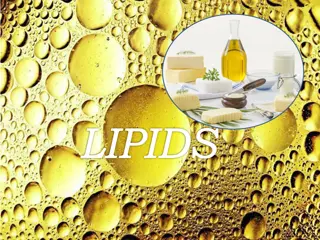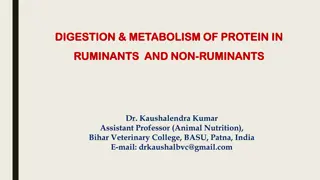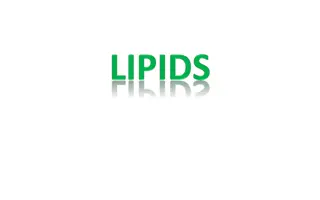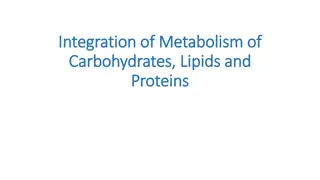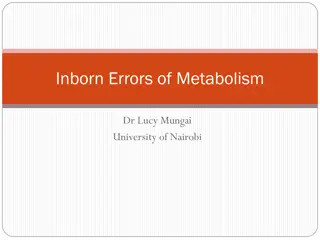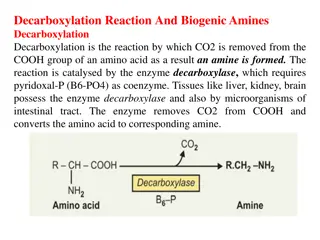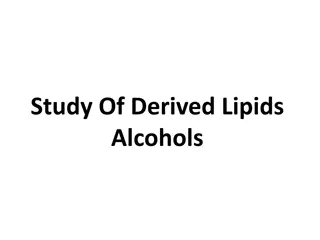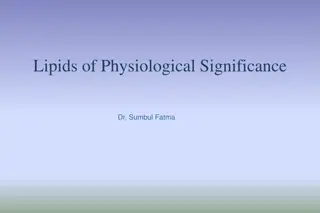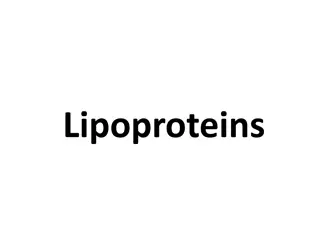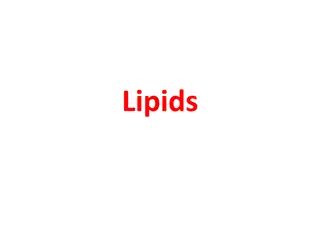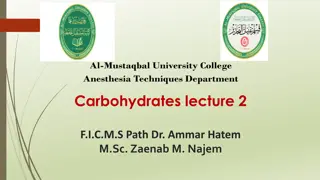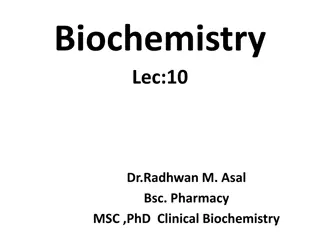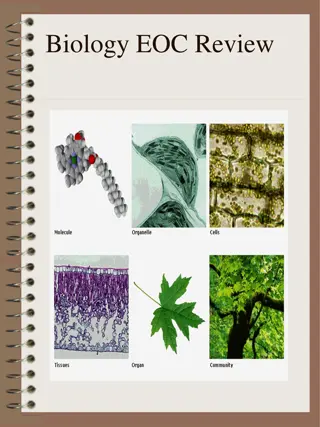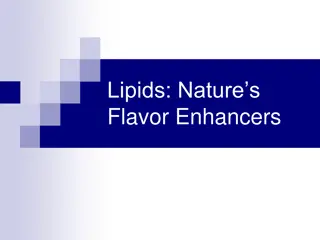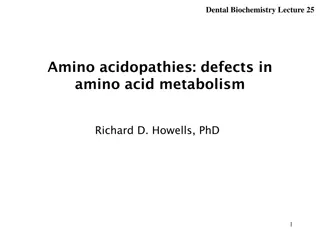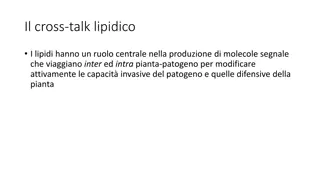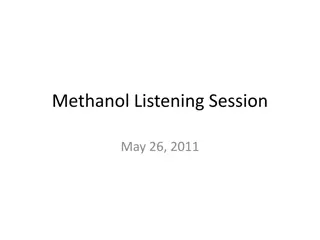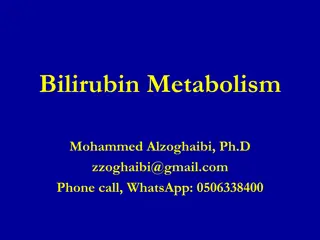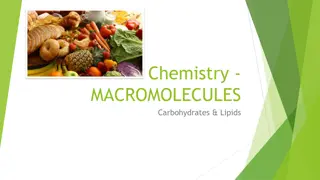Lipids Metabolism
Lipids are hydrophobic compounds composed mainly of carbon, hydrogen, and oxygen. They play crucial roles in the body, from lipid digestion to transport via lipoproteins. Learn about their classification, digestion process, and transport mechanisms.
Download Presentation

Please find below an Image/Link to download the presentation.
The content on the website is provided AS IS for your information and personal use only. It may not be sold, licensed, or shared on other websites without obtaining consent from the author.If you encounter any issues during the download, it is possible that the publisher has removed the file from their server.
You are allowed to download the files provided on this website for personal or commercial use, subject to the condition that they are used lawfully. All files are the property of their respective owners.
The content on the website is provided AS IS for your information and personal use only. It may not be sold, licensed, or shared on other websites without obtaining consent from the author.
E N D
Presentation Transcript
Lipids Lipids are compounds that are insoluble in water, but soluble in an organic solvent (e.g., ether, benzene, acetone, chloroform) lipid composed mainly from C, H, O The main feature, in all lipids, is the large number of carbon-hydrogen bonds which makes them non-polar.
LIPID DIGESTION Typical high-fat meals contain gram-level amounts o f triglycerides and milligram level amounts of cholesterol and cholesterol esters. Upon entry into the intestinal lumen, bile is secreted by the liver to emulsify the lipid contents. The pancreas secretes pancreatic lipase, colipase, and cholesterol esterase that degrade the lipids to 2-monoglyceride, fatty acids, and cholesterol. These lipids are absorbed and re-esterified to triglycerides and cholesterol esters and packaged, along with apoprotein B-48 and other lipids (e.g., fat-soluble vitamins), into chylomicrons. Normally, there is very little lipid loss in stools. Defects in lipid digestion result in steatorrhea, in which there is an excessive amount of lipids in stool (fatty stools).
Lipid Transport Lipid Transport as lipoproteins, which are clusters of lipids and proteins that are used as transport vehicles for fat, 4 main classes are present: Chylomicrons VLDL = very low density lipoproteins LDL = low density lipoproteins HDL = high density lipoproteins Free fatty acids are attached to albumin and transported through blood
What are lipoproteins and why do we need them? Lipoproteins are molecules that interact with water insoluble fat molecules, and transports those fats in the plasma The textbook describes the lipoproteins as oil tankers Different lipoproteins are responsible for the transportation of different fats Lipoproteins allow fat to be dissolved into the plasma 7
Lipoproteins Lipids are transported through physiological fluids as a lipoprotein complex . These are spherical particles: Core: relatively non-polar Triglycerides Cholesterol esters Surface: relatively polar Phospholipids Proteins cholesterol
Lipoproteins Lipoproteins contain one or more specific proteins called apolipoproteins located near the surface Apolipoproteins have specific functions: Activate metabolic enzymes Maintain structural integrity of lipoprotein Facilitate uptake of lipoprotein into cells Research indicates apolipoprotein abnormalities may lead to abnormal lipid metabolism and metabolic disorders such as: Atherosclerosis Cardiovascular disease Stroke Alzheimer s disease
lipoproteins There are 4 types of lipoproteins Chylomicrons Transport of dietary triglycerides ( exogenous TG) from the GI tract to the liver Very Low Density Lipoproteins ( VLDL ) Transport of synthesized triglycerides ( Endogenous TG) from the liver to tissues for storage and energy Low Density Lipoproteins ( LDL ) Transports cholesterol to peripheral tissues High Density Lipoproteins ( HDL ) Transports cholesterol away from the peripheral tissues to the liver 11
Lipid Metabolism This includes lipogenesis and lipolysis , the most important to be studied are the pathways concerned with triglycerides and cholesterol metabolisms: Reserves of stored triglycerides are mobilized as needed for energy production. Fat mobilization is stimulated by epinephrine. The triglycerides are hydrolyzed to fatty acids and glycerol and enter the blood stream. Glycerol is converted to glycerol- 3 phosphate and then to dihydroxyacetone phospahte, which enters glycolysis for energy production. Free fatty acids are converted to fatty acyl CoA molecules, which are broken down to acetyl CoA by beta oxidation. The acetyl CoA may be used for energy production by way of the citric acid cycle and the electron transport chain. Cholesterol is needed by almost all cells and is precursor for hormones and bile acids .
DE NOVO SYNTHESIS OF FATTY ACIDS A large proportion of the fatty acids used by the body is supplied by the diet. Carbohydrates and protein obtained from the diet in excess of the body s needs for these compounds can be converted to fatty acids, which are stored as triacylglycerols. In adult humans, fatty acid synthesis occurs primarily in the liver and lactating mammary glands and, to a lesser extent, in adipose tissue. This cytosolic process incorporates carbons from acetyl coenzyme A (CoA) into the growing fatty acid chain, using adenosine triphosphate (ATP) and reduced dinucleotide phosphate (NADPH). nicotinamide adenine
Fatty Acid Oxidation Fatty acids are degraded to acetyl CoA the process called -oxidation Fatty acids enter tissue cells in need of energy. Fatty acids must pass through the mitochondrial membrane to be oxidized and to produce energy. The passage cannot occur until the fatty acid is converted to its thioester with CoA. The product of this reaction is fatty acyl CoA. The reaction is: Fatty acid + HS CoA + ATP Fatty acyl CoA + AMP + Pi This is known as activation of fatty acid. Fatty acids must be activated before they are degraded to produce energy. Fatty acids are activated in the cytosol, but oxidation occurs in the mitochondria.
Key Concepts in Lipid catabolism -oxidation is the mitochondrial process by which fatty acids are oxidized to yield NADH, FADH2, and acetyl-CoA. Ketogenesis takes place in liver mitochondria when acetyl-CoA levels are high and oxaloacetate levels are low.
Beta oxidation The formation of fatty acyl CoA molecule prepares fatty acids for entry into the mitochondria. Carnitine helps fatty acly CoA to enter mitochondria. There they are degraded in the catabolic process called beta oxidation. During beta oxidation, the third (or beta) carbon of the saturated fatty acid chain of the fatty acyl CoA is oxidized to a ketone. Beta oxidation is a spiral pathway. Each round consists of four enzyme-catalyzed steps that yield one molecule of acetyl CoA and an acylCoA shortened by two carbons, which becomes the starting substrate for the next round. Seven rounds of beta oxidation degrade a C16fatty acid to eight molecules of acetyl CoA. Complete oxidation of one molecule of palmitic acid to carbon dioxide and water yields 129 molecules of ATP. One round of beta oxidation yields 17 ATP. Beta Oxidation is regulated by availability of free CoA, by the ratios of NAD/NADH and Q2.
-oxidation yields large amounts of ATP The energy conversion process of fatty acid --> ATP involves oxidation of fatty acids by sequential degradation of C2units leading to the generation FADH2, NADH, and acetyl CoA. Palmitate (C16) The subsequent oxidation of these reaction products by the citrate cycle phosphorylation generates lots of ATP. and oxidative
Ketogenesis Ketogenesis (synthesis of ketone bodies) takes place primarily in the liver. When fatty acid oxidation produces more acetyl-CoA than can be combined with Oxaloacetate to form citrate, then the "extra" acetyl-CoA is converted to acetoacetyl-CoA and ketone bodies. Keton bodies includes : acetoacetate , aceton & - hydroxy butric acid Acetyl-CoA oxidation enters the Citrate Cycle only if carbohydrate metabolism is properly balanced. derived from fatty acid
Cholesterol synthesis Synthesis of cholesterol takes place in cytosol. The carbon skeleton of cholesterol is formed from acetyl CoA. The pathway of cholesterol biosynthesis has over 30 steps. The rate determining step of cholesterol synthesis and the major control point is the conversion of hydroxy methyl glutarate co A (HMG-COA) to mevolonic acid. Some intermediate steps of cholesterol synthesis are mevolonic acid squalene zymosterol cholesterol.
The fate of cholesterol 1. It can be incorporated into a cell membrane. 2. It may be acylated cholesteryl ester for storage. to form 3. It is precursor of steroid hormone (estrogen, testosterone) 1. It is a precursor of bile acids.


